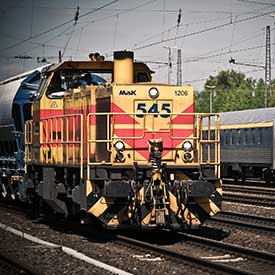Texas Train Accident Attorney
When a driver attempts to cross railroad tracks and either stalls or misjudges the speed at which a train is approaching, a serious or fatal accident may occur.
Whether you’re a passenger, a railroad worker or a bystander, you don’t need to be told how powerful and dangerous a train is. Texans encounter trains every day, and we know the risks we face when they pass through our communities.
Sadly, many of us also know what it’s like when we are involved in a train accident. As one can imagine, these accidents lead to some of the most devastating personal injuries. If you’ve been injured in a train accident, then you should be aware of your legal options.
Austin train accident attorney Chip Evans helps injured clients get compensation for the injuries they’ve suffered. He represents workers, vehicle occupants and passengers to make sure they receive the payment they deserve.
If you or a loved one has had the misfortune of being involved in a train accident, don’t hesitate to contact us today to schedule a free, no-obligation consultation.
Who Files Train Accident Injury Claims?
A train can leave an entire group of people seriously injured, or it can harm just one individual. As you’ll learn below, these accidents are more common than you think. When a train is defective or a conductor fails to do their job, everyone in that train’s path and everyone on board is in danger. A train accident injury claim can be filed by…
- A railroad or train worker
- A driver struck by a train
- A train passenger
- A pedestrian injured by a train
- A family of someone fatally injured by a train.
Remember that if you’re injured in a train accident, you don’t need to pay the price for someone else’s mistakes. Contact Chip Evans today to learn how the EVANS / DESHAZO / REILLEY Law Firm can help.
How a Train Can Cause Injury and Death
Trains are some of the deadliest vehicles when they aren’t properly operated or maintained. Train accidents often happen because of…
- Defective parts
- Improper maintenance
- Fatigued, distracted or negligent operators
- Derailments
- Protruding train parts
- Obstructed roadways due to improperly parked trains.
These are just a few examples of things that can go wrong, but given the complexities of trains, train tracks and protective devices like road warning signals, it’s easy to see that many other hazards can arise when a train is defective or operated improperly.
Types of Injuries Suffered in Train Accidents
Train-related injuries are usually severe, and they often include several different injuries. Some of the most common train accident injuries include…
- Traumatic brain injuries
- Spinal cord injuries
- Complex bone fractures
- Extensive soft tissue damage
- Internal injuries and organ damage
- Fatal injuries.
These injuries can ruin not just a victim’s life, but also the lives of the victim’s family members. Severe injuries require extensive, ongoing and costly medical care. They rob people of the ability to earn an income. They cause severe emotional and psychological suffering.
All these costs should be factored in when determining how much to seek in a lawsuit. Chip Evans has helped residents across Texas get payment that reflects all the costs they’ve faced. We believe that you shouldn’t be forced to pay for injuries that were someone else’s fault. Whether it’s a negligent train operator or a negligent railroad company, at-fault parties can be held responsible for the suffering they’ve caused.
Contact the EVANS / DESHAZO / REILLEY Law Firm today to schedule a free consultation.
Train Accidents in Texas – By the Numbers
When a driver attempts to cross railroad tracks and either stalls or misjudges the speed at which a train is approaching, a serious or fatal accident may occur.
In 2014, Texas had the highest number of railroad crossing collisions – 287 – which caused 104 injuries and 19 fatalities, according to the Federal Railroad Administration. The state also ranked second for the number of people killed (41) and injured (39) while walking on or near railroad tracks.
With approximately 11,000 miles of railroad track in Texas, there are numerous rail crossings throughout the state. Each of those crossings presents a danger to motorists. Safety advocates say that while motorist behavior is often cited as the reason for serious and fatal collisions with trains, trackside warning systems may be at least partially to blame, if they haven’t been adjusted to account for the speed at which modern trains move.
If a train collision has injured you or someone in your family, we may be able to help. In some cases, families may be entitled to compensation for their losses, pain, and suffering. Call us today to learn what we can do for you.
HAZARDS FOR WORKERS
 Railroad Workers United, an advocacy organization for rail workers, lists several hazards of the occupation – such as workforce reductions that result in pressure on employees to put in long hours and work while fatigued. And looking at reports of fines against railroad companies for environmental and occupational hazards, it’s clear that many of them aren’t known for their safety records.
Railroad Workers United, an advocacy organization for rail workers, lists several hazards of the occupation – such as workforce reductions that result in pressure on employees to put in long hours and work while fatigued. And looking at reports of fines against railroad companies for environmental and occupational hazards, it’s clear that many of them aren’t known for their safety records.
If you’re a railroad worker who was injured in an on-the-job accident, we may be able to help you. Call us today to find out whether you have a case: 1-855-414-1012.
The Fort Worth-based BNSF railroad, which accounted for 2,662 accidents in Texas in a 10-year time span, was fined thousands of dollars for 14 hazardous material spills in Washington in a span of about three months. The Occupational Safety and Health Administration also ordered BNSF to revise its whistleblower provisions, because the company had intimidated workers or discouraged them from reporting injuries. In 2013, OSHA ordered Union Pacific to pay $309,000 in back wages, benefits, and attorney fees to a conductor who was fired after reporting a defect in a train that injured another worker.
Train accidents don’t just harm people crossing the tracks. They harm a large number of railroad workers every year; and with an industry-wide history of pressuring workers not to report injuries, it’s difficult to say just how many people have been injured while working a railway job.
AGING INFRASTRUCTURE
In November 2012, four veterans died when a train hit their parade float as it was crossing a section of railroad track in Midland. A director with the Texas Department of Transportation reported that trains routinely travel that track at 70 mph, although the crossing was designed to handle speeds only less than 25 mph.
Some sections of U.S. railroad are 100 years old, built at a time when trains moved more slowly. These old railways have been weathered by time and now show rust, cracked beams, and other structural deficiencies. Signal systems that warn drivers of approaching trains may be faulty, as well.
While Texans generally hear about high-profile train crashes in which multiple fatalities occur, statistics indicate there may be many more crashes than most people realize.
According to the Federal Railroad Administration, from January 2006 through September 2015:
- 71 railroad companies operating in Texas accounted for 10,504 accidents/incidents, with Union Pacific accounting for 51 percent of those events.
- 98 crashes caused damage exceeding $500,000.
- Railroad signals were a factor in 54 train accidents, and tracks were blamed for 882 accidents.
- Highway-rail incidents killed 247 people and injured 1,054.
- Other incidents/accidents – those not considered train accidents or crossing incidents – killed 375 people and injured 3,963.
Those “other incidents” may include accidents on the job, like the one in Mathis in 2013 that killed two workers who were performing maintenance on a bridge.
MAKING CHANGES
Since 2006, states have received about $220 million a year in federal funding for railroad improvements, which typically covers about 90 percent of the cost of updating railroad crossings. With the number of railroad crossings in Texas, it may take some time to ensure that all of them are operating safely. The safest crossing, of course, is either a bridge that passes over railroad tracks or a tunnel that passes beneath, but the cost of building such infrastructure is too high, for a state already struggling to maintain other aging infrastructure.
While it’s true that driver error is a contributing cause in many railroad crashes, several collisions can also be blamed on poor crossing design and a lack of adequate warning systems. If you’ve been injured in a train accident, we can help. We will investigate the accident to determine who was at fault, and we’ll hold them accountable for the harm they’ve caused.
Chip Evans Can Help
Train accidents are typically more complex than other types of accident cases. If you’re looking for an attorney to handle your injury claim, make sure they know the law and that they have a track record of getting results for their clients.
Chip Evans has a track record of getting real results for his clients. He knows how to deal with railroad and insurance companies to make sure his clients are treated fairly. Our team understands how serious these cases are in the lives of our clients, and we make sure to give their case the time, attention and dedication they deserve.
If a Texas railroad accident has injured you or someone in your family, don’t wait to get help. Call us today for your no-obligation consultation, or fill out our online contact from. We want to learn more about your situation. More importantly, we want to get you the payment you need to get your life back. Get in touch with the EVANS / DESHAZO / REILLEY Law Firm today.

 Serving Clients Throughout Texas
Serving Clients Throughout Texas


 Chip Evans is a partner at Evans & Herlihy. Chip brings to the firm more than 20 years of experience as a trial lawyer representing Plaintiffs. It is the desire to help individuals, not corporations, that attracts Chip to this side of the docket. [
Chip Evans is a partner at Evans & Herlihy. Chip brings to the firm more than 20 years of experience as a trial lawyer representing Plaintiffs. It is the desire to help individuals, not corporations, that attracts Chip to this side of the docket. [ 







